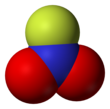| |||
| Identifiers | |||
|---|---|---|---|
| UNII | |||
| Properties | |||
| FNO2 | |||
| Molar mass | 65.003 g·mol−1 | ||
| Melting point | −166 °C (−267 °F; 107 K) | ||
| Boiling point | −72 °C (−98 °F; 201 K) | ||
| Related compounds | |||
Other anions
|
nitryl chloride, nitryl bromide | ||
Other cations
|
nitrosyl fluoride, sulfuryl fluoride | ||
Except where otherwise noted, data are given for materials in their standard state (at 25 °C [77 °F], 100 kPa).
| |||
Tracking categories (test):
Nitryl fluoride, NO2F, is a colourless gas and strong oxidizing agent, which is used as an oxidizer in rocket propellants and as a fluorinating agent.[1] It is a molecular and not an ionic fluoride, as shown by its low boiling point and also by the short N-F bond length of 135 pm.[2]
Preparation
edit- Moissan and Lebeau were one of the first to document the preparation of nitryl fluoride in 1905.[3]
- Common method of developing nitryl fluoride in the 1930s was by a reaction of fluorine with nitrogen dioxide. However, Hetherington and Robinson found this method to be unsuitable because of the highly exothermic nature of this reaction, which is accompanied by a flame, and yields a mixture of oxyfluorides contaminated with silicon tetrafluoride.[3]
- In the 1950’s, Aynsley developed a simpler method of preparation in which anhydrous sodium nitrate was allowed to react with elemental fluorine. Although a nearly quantitative yield of nitryl fruoride was obtained, it was necessary to control the reaction temperature by adjusting the fluorine flow. This prevented the nitrogen dioxide from burning in the fluorine and causing an explosion of glassware.[3]
- In a publication in 1950, another method of preparation of nitryl fluoride consisted of the use of nitrogen dioxide, which was prepared by bubbling oxygen into liquid nitric oxide. Fluorine was then passed through a sodium fluoride tower and allowed to reach with the liquid nitric oxide in the reactor. This fluorination process was continued until a colorless liquid product was obtained. The product was frozen down and evacuated to remove any excess fluorine present. The observed molecular weight was 67.4. the product had a boiling range of 200-201 degrees Kelvin with a yield of greater than 90%.[4]
Thermodynamic Properties
edit- IR and Raman Spec of nitryl fluoride was studied by Dodd, Rolfe, and Woodward and the microwave spectrum has been reported by Smith and Magnuson.[5]
- Using those specs data, the thermodynamic functions of Nitryl fluoride were in the temperature range from 200 to 1200 degrees Kelvin at 100 degree intervals.
- An approximate value for the standard heat of formation of FNO2 is -19 +- 2 kcal/mol.3
- The equilibrium of the unimolecular decomposition of FNO2 lies on the side of the reactants by at least six orders of magnitude at 500 degrees Kelvin, and two orders of magnitude at 1000 degrees Kelvin.[5]
- The homogeneous thermal decomposition cannot be studied at temperatures below 1200 degrees Kelvin.[5]
- The equilibrium shifts towards the reactants with increasing temperature.[5]
- The dissociation energy of 46.0 kcal of the N-F bond in nitryl fluoride is about 18 kcal less than the normal N-F single bond energy. This can be attributed to the “reorganization energy” of the NO2 radical that is the NO2 radical in FNO2 is less stable than the free NO2 molecule. Qualitatively speaking, the odd electron “used up” in the N-F bond forms a resonating three-electron bond in free NO2, thus stabilizing the molecule with a gain of 18 kcal.[5]
See also
editReferences
edit- ^ Merck Index, 13th edition (2001), p.1193
- ^ F.A.Cotton and G.Wilkinson, Advanced Inorganic Chemistry, 5th edition (1988), Wiley, p.333
- ^ a b c Davis, Ralph A. "Preparation of Nitryl Fluoride". Inorganic Chemistry. 2 (6): 1300–1301. doi:10.1021/ic50010a048.
{{cite journal}}: Unknown parameter|coauthors=ignored (|author=suggested) (help) - ^ Faloon, Albert V. Journal of the American Chemical Society. 73 (6): 2937–2938. doi:10.1021/ja01150a505.
{{cite journal}}: Missing or empty|title=(help); Unknown parameter|coauthors=ignored (|author=suggested) (help) - ^ a b c d e Tschuikow-Roux, E. "THERMODYNAMIC PROPERTIES OF NITRYL FLUORIDE". Journal of Physical Chemistry. 66 (9): 1636–1639. doi:10.1021/j100815a017.

